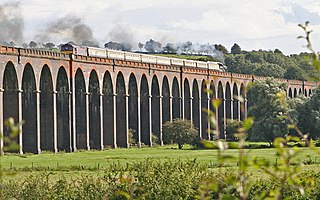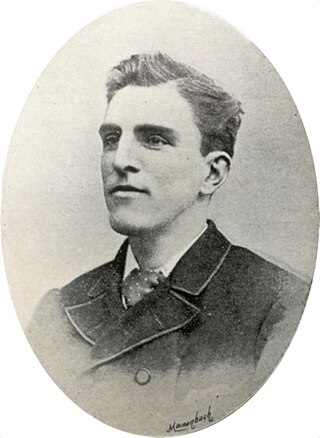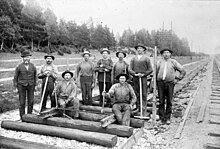The Grand Western Canal ran between Taunton in Somerset and Tiverton in Devon in the United Kingdom. The canal had its origins in various plans, going back to 1796, to link the Bristol Channel and the English Channel by a canal, bypassing Lands End. An additional purpose of the canal was the supply of limestone and coal to lime kilns along with the removal of the resulting quicklime, which was used as a fertiliser and for building houses. This intended canal-link was never completed as planned, as the coming of the railways removed the need for its existence.

Gandy dancer is a slang term used for early railroad workers in the United States, more formally referred to as section hands, who laid and maintained railroad tracks in the years before the work was done by machines. The British equivalents of the term gandy dancer are navvy, originally builders of canals, or inland navigations, for builders of railway lines, and platelayer for workers employed to inspect and maintain the track. In the Southwestern United States and Mexico, Mexican and Mexican-American track workers were colloquially traqueros.

Kilsby is a village and civil parish in West Northamptonshire, England. It is situated a short distance south of the border with Warwickshire approximately five miles southeast of Rugby. The parish of Kilsby, which includes Barby Nortoft, was estimated to have a population of 1,268 in 2020.

A steam shovel is a large steam-powered excavating machine designed for lifting and moving material such as rock and soil. It is the earliest type of power shovel or excavator. Steam shovels played a major role in public works in the 19th and early 20th century, being key to the construction of railroads and the Panama Canal. The development of simpler, cheaper diesel, gasoline and electric shovels caused steam shovels to fall out of favor in the 1930s.

Thomas Brassey was an English civil engineering contractor and manufacturer of building materials who was responsible for building much of the world's railways in the 19th century. By 1847, he had built about one-third of the railways in Britain, and by time of his death in 1870 he had built one in every twenty miles of railway in the world. This included three-quarters of the lines in France, major lines in many other European countries and in Canada, Australia, South America and India. He also built the structures associated with those railways, including docks, bridges, viaducts, stations, tunnels and drainage works.

Welland Viaduct, Harringworth Viaduct or Seaton Viaduct, crosses the valley of the River Welland between Harringworth in Northamptonshire and Seaton in Rutland, England.

Hincaster is a small hamlet and civil parish in the South Lakeland district of Cumbria, England, located between Kendal and Milnthorpe. In the 2001 census the parish had a population of 195, increasing at the 2011 census to 209.
The United Order of General Labourers was a trade union representing labourers, mostly in the construction industry, in the United Kingdom.
The Altogether Builders' Labourers and Constructional Workers' Society was a trade union representing labourers in the construction industry in the United Kingdom.
Dónall Peadar Mac Amhlaigh was an Irish writer active during the 20th century. A native of County Galway, he is best known for his Irish-language works about life as a labourer in the post-Second World War-era, as part of the Irish diaspora in Britain. His first book, Dialann Deoraí, is his most widely known and has been translated into English under the title "An Irish Navvy: The Diary of an Exile".
The Public Works and Constructional Operatives' Union was a trade union representing labourers in the United Kingdom.

Paddy mails, generally considered as being workmen's trains, were operated by, or for many companies to transport their workers to their place of work or between their sites of work.

Work (1852–1865) is a painting by Ford Madox Brown that is generally considered to be his most important achievement. It exists in two versions. The painting attempts to portray, both literally and analytically, the totality of the Victorian social system and the transition from a rural to an urban economy. Brown began the painting in 1852 and completed it in 1865, when he set up a special exhibition to show it along with several of his other works. He wrote a detailed catalogue explaining the significance of the picture.

McAlpine's Fusiliers is an Irish ballad set to a traditional air, popularised in the early 1960s by Dominic Behan.
The Syston and Peterborough Railway was an early railway in England opened between 1846 and 1848 to form a connection from the Midland Counties Railway near Leicester to Peterborough, giving access to East Anglia over the Eastern Counties Railway. The project was part of the ambition of George Hudson to establish and maintain a monopoly of railway service over a large area of England. The surveying of the line achieved notoriety when Robert Sherard, 6th Earl of Harborough, who was hostile to railways, arranged a battle to obstruct surveys of the proposed line, and later of its construction.

Bramhope Tunnel is on the Harrogate Line between Horsforth station and the Arthington Viaduct in West Yorkshire, England. Services through the railway tunnel are operated mainly by Northern. The tunnel was constructed during 1845–1849 by the Leeds and Thirsk Railway. It is notable for its 2.138-mile (3.441 km) length and its Grade II listed, crenellated north portal. The deaths of 24 men who were killed during its construction are commemorated in Otley churchyard by a monument that is a replica of the tunnel's north portal.

Wellington Bank is a steep railway embankment and associated climb located on the Bristol to Exeter line, that climbs from just northeast of Wellington, Somerset, until its peak at Sampford Arundel, where it enters Whiteball tunnel and travels under the Whiteball Hill.

Jericho is a British period drama television series created and written by Steve Thompson; it was directed by Paul Whittington. The eight-part series premiered on ITV between 7 January and 25 February 2016. The series re-imagines the building of the Ribblehead Viaduct as a Western-inspired story. It is set in the fictional town of Jericho, a shanty town in the Yorkshire Dales of England, which springs up around the construction of a railway viaduct in the 1870s.
The United Builders' Labourers Union was a trade union representing labourers in the construction industry in the United Kingdom.

William Leonard Hall was a British trade union leader, journalist, and socialist activist, who held prominent positions in the Independent Labour Party.















